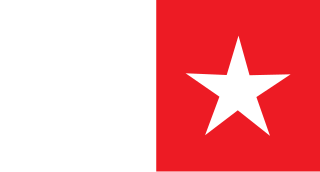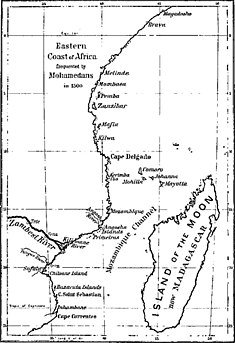
Swahili, also known by its native name Kiswahili, is the native language of the Waswahili who are found along the East African coast and litoral islands. Due to concerted efforts by the government of Kenya and Tanzania, Swahili is one of three official languages of the East African Community (EAC) countries, namely Burundi, Democratic Republic of Congo, Kenya, Rwanda, South Sudan, Tanzania, and Uganda. It is a lingua franca of other areas in the African Great Lakes region and East and Southern Africa, including some parts of the Democratic Republic of the Congo (DRC), Malawi, Mozambique, the southern tip of Somalia, and Zambia. Swahili is also one of the working languages of the African Union and of the Southern African Development Community. The number of Swahili speakers, be they native or second-language speakers, is estimated to be approximately 200 million.

Lower Juba is an administrative region (gobol) in southern Somalia. With its capital at Kismayo, it lies in the autonomous Jubaland region. It has green forests and wild life animals such as lions, giraffes, hippos, crocodiles, and hyenas.

The East African Community (EAC) is an intergovernmental organisation composed of seven countries in the African Great Lakes region in East Africa: the Democratic Republic of the Congo, the United Republic of Tanzania, the Republics of Kenya, Burundi, Rwanda, South Sudan, and Uganda. Uhuru Kenyatta, the president of Kenya, is the current EAC chairman. The organisation was founded in 1967, collapsed in 1977, and was revived on 7 July 2000.

The North Eastern Province is one of the former provinces in Kenya. It has a land area of 127,358.5 km2, with its capital at Garissa. Previously known as the Northern Frontier District (NFD), the North Eastern Province territory was carved out of the present-day southern Somalia during the colonial period.

Wituland was a territory of approximately 3,000 square kilometres (1,200 sq mi) in East Africa centered on the town of Witu just inland from Indian Ocean port of Lamu north of the mouth of the Tana River in what is now Kenya.
Moyale is a market town, found between the border of Ethiopia and Kenya, and is the administrative centre for two Ethiopian woredas, Moyale of Oromia Region and Moyale of Somali Region
The Bajuni Islands are an archipelago in southern Somalia. They are situated in the Somali sea in the southern coast of Jubaland, from Kismayo to Ras Kiyamboni.

The Garre is a major Somali clan whose origins trace back to Samaale who traces the lineage from the Arabian Peninsula through Aqiil Abu Talib. The Garre clan are considered to belong to the Digil clan family sub-clan of Digil-Rahanweyn clan of Rahanweyn Somali clan but genealogically descend from Gardheere Samaale. They are also categorized as southern Hawiye as well, as the Hawiye clan also pseudo-alliance with the Garre clan for a vision of not just strengthening Hawiye, but also a means of building powerful tribes that are aligned in purpose and strategy. Hawiye clan trace their ancestry to Irir Samaale who is the brother to Gardhere Samaale i.e their closer kin. The Garre are also classified in the Dir clan family.
The Pokomo people are a Bantu ethnic group of southeastern Kenya. The population in Kenya was 112,075 in 2019. They are a distinct ethnic group with their own sub-clans/tribes. Despite their proximity, they are not of the nearby Mijikenda people. They are predominantly agriculturalists and both freshwater and ocean fishermen living along the Tana River in Tana River County. They speak the Pokomo language, which is similar to Swahili.

Mpeketoni is a town in Lamu County, on the Kenyan coast. It is a settlement scheme started in 1960s by the first president of the Republic of Kenya, Jomo Kenyatta near a fresh water lake bearing his name.

The Bajuni people are an Bantu ethnic group mainly residing on the Bajuni Islands and surrounding coastal areas between the port city of Kismayo and Mombasa area of Kenya and Somalia’s southern border.
The Somali Bantus are a Bantu origin ethnic minority group in Somalia who primarily reside in the southern part of the country, primarily near the Jubba and Shabelle rivers. The Somali Bantus are descendants of enslaved peoples from various Bantu ethnic groups from Southeast Africa, particularly from Mozambique, Malawi, and Tanzania. The East African slave trade was not eliminated until the early parts of the 20th century.
The Shifta War or gaf Daba (1963–1967) was a secessionist conflict in which ethnic Somalis in the Northern Frontier District (NFD) of Kenya attempted to join Somalia. The Kenyan government named the conflict "shifta", after the Somali word for "bandit", as part of a propaganda effort. The Kenyan counter-insurgency General Service Units forced civilians into "protected villages" as well as killing livestock kept by the pastoralist Somalis.

Oltre Giuba or Trans-Juba was an Italian colony in the territory of Jubaland in present-day southern Somalia. It lasted for one year, from 1924 until 1925, when it was absorbed into Italian Somaliland. Trans-juba is the former name of Jubaland, a federal member state of Somalia.
The Aweer are a Cushitic ethnic group inhabiting the Coast Province in southeastern Kenya. Some members are also found in southern Somalia. They are indigenous foragers, traditionally subsisting on hunting, gathering, and collecting honey.

The Somali–Kenyan conflict has been an issue within Kenya since the colonial period. Problems have ranged from petty skirmishes between the two communities and have led to terrorist attacks, police harassment, extortion, home invasions, physical violence, and massacres perpetrated against Somalis and Kenyans.
Between 15 June and 17 June 2014, more than 60 people were killed in attacks in and near Mpeketoni, Kenya. The Somalia-based Al-Shabaab militant group claimed responsibility, but the Kenyan President Uhuru Kenyatta asserted that the attacks were organized by local politicians with ties to a network of gangs. Correspondents from the area suggested that the attacks may have been motivated by ethnic or religious hatred, or revenge for land grabbing.

Maritime archaeology in East Africa spans the range from the horn of Somalia south to Mozambique, and includes the various islands and island chains dotting the map off the coast of Somalia, Mozambique, Tanzania and Kenya. Primary areas along this coast include the Zanzibar, Lamu, and Kilwa Archipelagos. Although East African societies developed nautical capabilities for themselves, most of the maritime artifacts point to external merchants from Mediterranean cultures like Egypt and Greece, Indian and Chinese from South and East Asia in the early stages, to the great European powers during the Ages of Colonization and Imperialism.
The Oromia–Somali clashes flared up in December 2016 following territorial disputes between Oromia region and Somali region's Government in Ethiopia. Hundreds of people were killed and more than 1.5 million people fled their homes.
The Northern Monsoon Current coast is a marine ecoregion along the eastern coast of Africa. It extends along a portion of the coasts of Somalia and Kenya, from south of Lamu in Kenya to north of Mogadishu in Somalia. It adjoins the Central Somali coast ecoregion to the north, and the East African coral coast ecoregion to the south.











